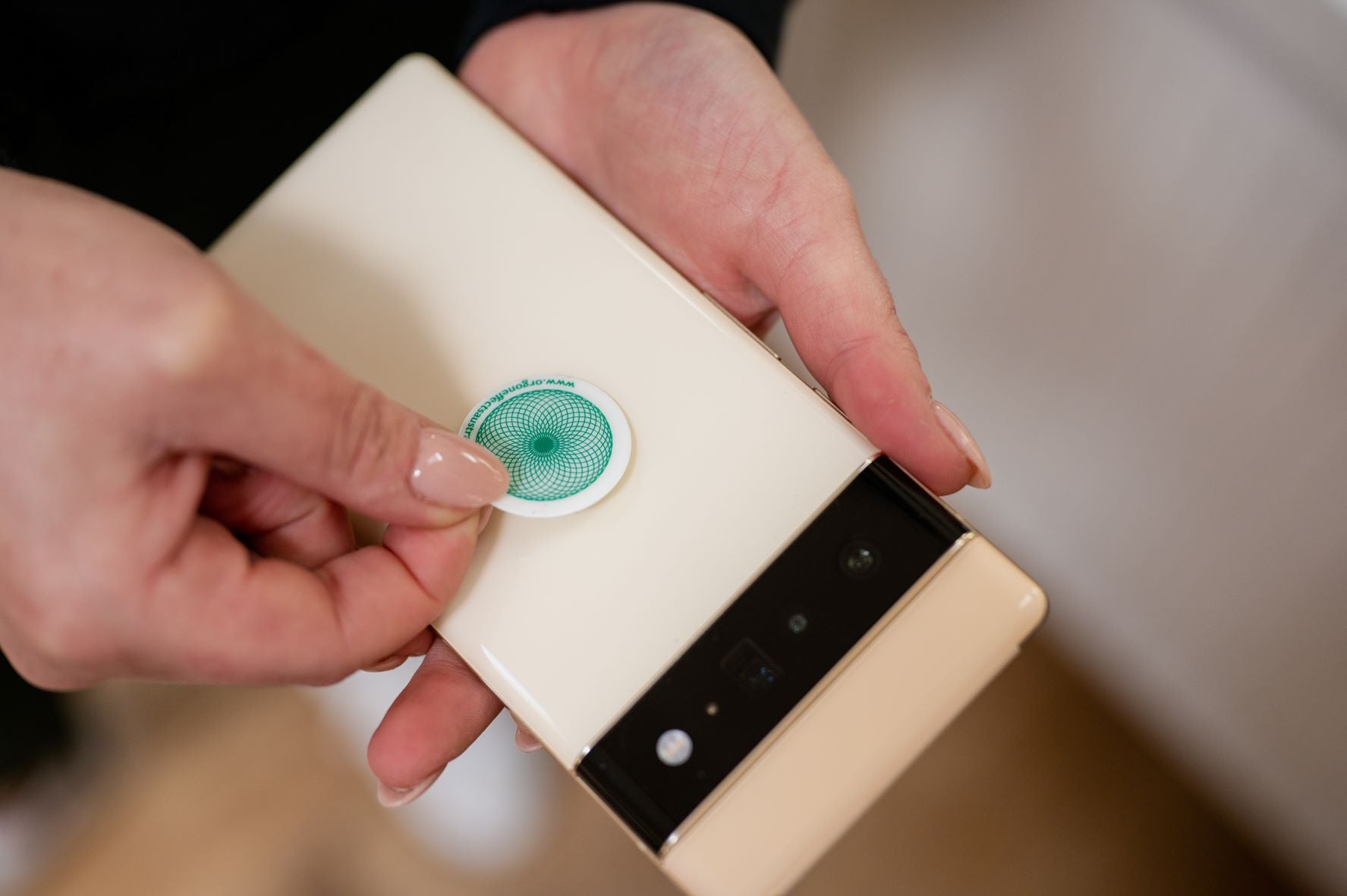We are constantly exposed to EMF whether at home, work or on the go, but why is EMF exposure bad for you and what can you do about it?
What is EMF?
Electromagnetic fields (EMF) are generated whenever electric current flows through a conductor or when electrically charged particles move.
EMF can be found in various sources such as power lines, electrical wiring, electronic devices, and even natural sources like the sun.
This form of energy is invisible and easily penetrates through most materials, making it a potential concern for human health and the environment.
Understanding the basics of EMF is important in order to address any potential risks and concerns associated with its exposure.
Types of EMF

Electromagnetic fields (EMFs) can be classified into two main types: high-frequency and low to mid-frequency radiation.
High-frequency EMFs include radio frequency and microwave radiation, and are emitted from sources such as cell phones, Wi-Fi, and microwave ovens.
Low to mid-frequency radiation, on the other hand, includes extremely low frequency (ELF) radiation from power lines, appliances, and electrical wiring.
Ionizing and Non-Ionizing Radiation
EMFs can also be categorized as ionizing or non-ionizing radiation. Ionizing radiation, such as X-rays and gamma rays, has enough energy to remove tightly bound electrons from atoms, causing damage to DNA and potentially leading to cancer.
Non-ionizing radiation, including the aforementioned high and low to mid-frequency EMFs, does not have enough energy to ionize atoms but can still cause biological effects, like heating tissues and disrupting cell functions.
Some studies have also suggested this type of EMF can cause cancer. Non-ionizing EMFs are listed as 'possibly carcinogenic' by International Agency for Research on Cancer (IARC).
Natural Sources of EMF
Natural sources of EMFs include the Earth's magnetic field, cosmic radiation, and even the human body, while human-made sources encompass a wide range of devices and technologies.
While the effects of EMF exposure on the body are still being studied, potential risks include increased cancer risk, changes in brain activity, and reproductive issues.
How Does EMF Affect Human Health?

Electromagnetic fields (EMF) are a form of radiation that is emitted from various sources such as power lines, cell phones, and Wi-Fi devices.
There has been ongoing debate and concern about the potential impact of EMF on human health.
Some studies have suggested that prolonged exposure to EMF may have adverse effects on the nervous system, disrupt sleep patterns, increase the risk of certain cancers, and affect overall well-being.
Although the research on this topic is still inconclusive, it is important to understand the potential risks and take necessary precautions to minimize exposure to EMF.
Adverse Effects of High Levels of Exposure

Exposure to high levels of electromagnetic fields (EMF) has been linked to potential adverse effects on human health.
Biological responses to high levels of EMF can include increased body temperature, changes in heart rate, and disrupted nerve cell function.
Long-term exposure has been associated with an increased risk of certain cancers, reproductive problems, and neurological disorders.
Biological effects from EMF exposure may or may not result in adverse health effects, depending on the intensity and duration of the exposure. The impact on health is a significant concern, as excessive EMF exposure has the potential to contribute to various health issues.
To mitigate these risks, national and international organizations have established guidelines to restrict exposure to higher levels of EMF.
For example, the International Commission on Non-Ionizing Radiation Protection (ICNIRP) and the Federal Communications Commission (FCC) in the United States have set limits on EMF exposure to protect public health.
High levels of exposure to electromagnetic fields can have adverse biological responses and overall impact on health. It is crucial to adhere to national and international guidelines to minimize potential risks from excessive EMF exposure.
Low-Level Exposure and Biological Effects

Low-level EMF exposure has been a topic of debate in relation to its potential biological effects and associated health concerns.
Some studies have suggested that low-level EMF exposure may lead to an increased risk of certain health issues, such as cancer, infertility, and neurological disorders.
The potential risks and uncertainties associated with EMF exposure on human health are still not fully understood.
There is ongoing research to better understand the biological effects of low-level EMF exposure and its implications for human health.
Some findings have suggested that there may be subtle biological changes at the cellular level as a result of EMF exposure, but the significance of these changes in terms of health outcomes is still uncertain.
Overall, the current debate on low-level EMF exposure raises important questions about its potential impact on human health.
Ongoing research is needed to clarify the potential risks and uncertainties associated with EMF exposure, and to provide a clearer understanding of its biological effects.
Long-Term Health Risks From EMF Exposure

Exposure to electromagnetic fields (EMFs) has been associated with potential long-term health risks.
One concern is the disruption of the body's natural electromagnetic field, which can lead to various health issues.
Extremely low frequency (ELF) EMFs, commonly emitted from power lines and electrical appliances, have been linked to an increased risk of cancer, particularly childhood leukemia.
The World Health Organization has classified ELF EMFs as a possible carcinogen.
Radiofrequency (RF) EMFs, emitted from wireless devices such as cell phones and Wi-Fi routers, have also raised concerns.
Studies have suggested a possible link between RF EMFs and brain tumors, DNA damage, and fertility problems.
The impact of RF EMFs on human health is still a topic of ongoing research, but precautionary measures are recommended.
Long-term exposure to EMFs may have adverse effects on health, including an increased risk of cancer from ELF EMFs and potential risks to brain tumors, DNA damage, and fertility from RF EMFs.
It is essential to be mindful of EMF exposure and take steps to minimize potential risks, such as reducing the use of wireless devices and maintaining a safe distance from power lines and electrical appliances.
Possible Link Between Cancer and EMF Exposure

There has been ongoing research on the potential link between cancer and exposure to electromagnetic fields (EMF).
Some studies have suggested a possible association between EMF exposure and certain types of cancer, such as childhood leukemia.
The International Agency for Research on Cancer (IARC) classified EMF as a possible carcinogen in 2002, based on limited evidence of an association with childhood leukemia.
Further research is needed to better understand the potential risks and health effects of EMF exposure. Studies investigating the long-term effects of EMF from sources such as power lines, cell phones, and household appliances are essential to determining the extent of the relationship between EMF exposure and cancer.
How to Protect Yourself From EMF
To minimize potential health risks, individuals can take measures to reduce their EMF exposure. This can include using a hands-free device when using a cell phone, keeping a safe distance from power lines and electrical appliances, and minimizing the use of electronic devices in close proximity to the body.
Of course, with so many different sources of EMF and EMR all around us, regular and long-term exposure is inevitable and cannot be avoided.
Instead, we suggest using EMF protection products in order to safeguard yourself and your loved ones.
Our Geoclense and Dome Schumann Resonance Orgone Generators both offer whole-home EMF protection while our shungite and quantum pendants offer EMF protection while on the go.
Sources of EMF in Everyday Lives

In our modern world, electromagnetic fields (EMFs) are all around us, generated by various sources that have become an integral part of our everyday lives.
From the devices we use at home and work to the infrastructure of our cities, EMFs are present in numerous forms.
Understanding the sources of EMF in our everyday lives is important for managing and minimizing our exposure to these fields.
By recognizing where EMFs come from, we can take steps to protect ourselves and our families from potential health risks while still benefiting from the conveniences of modern technology.
Mobile Phones
Mobile phone use has been associated with various health risks, both physical and mental.
The physical effects include potential risks of headaches, sleep disturbances, and radiation exposure.
Prolonged use of mobile phones can also result in neck and shoulder pain due to poor posture. In terms of mental effects, excessive use of mobile phones has been linked to increased stress, anxiety, and depression.
Mobile phone base stations emit radiofrequency (RF) emissions, which have raised concerns about potential health risks for users.
Exposure to RF emissions from these base stations has been associated with the increased risk of cancer, especially in the long term.
The Federal Communications Commission (FCC) has established guidelines for safe human exposure to radiofrequency energy for wireless devices. These guidelines are based on the specific absorption rate (SAR), which measures the amount of RF energy absorbed by the body when using a wireless device.
Consumers can find the SAR value for a specific phone in the user manual or by visiting the FCC's website.
While mobile phones and base stations provide convenience, it is important to be aware of the potential health risks associated with their use and to adhere to the FCC guidelines for safe exposure to radiofrequency energy.
Check out: iPhone 12 Banned
Wireless Device Networks
To ensure compliance with FCC exposure limits for wireless devices, such as cellphones and tablets, you can check the specific absorption rate (SAR) value of the device on the FCC ID Search database using the device's FCC ID number.
This database provides information on the SAR value, which measures the amount of radiofrequency energy absorbed by the body when using a wireless device.
It's important to choose devices with SAR values within the FCC's acceptable limits to minimize exposure to radiofrequency energy.
At home, you can reduce EMF exposure by using a Wi-Fi router with an on/off button. This allows you to turn off the Wi-Fi signal when it's not in use, reducing the overall electromagnetic field (EMF) emissions. Additionally, connecting to the internet using a wired connection instead of Wi-Fi can further minimize EMF exposure. By using these options, you can ensure compliance with FCC exposure limits and reduce EMF exposure in your home.
Smart Meters
Smart meters, which are advanced utility meters designed to monitor and transmit real-time energy usage data, emit electromagnetic fields (EMFs) as part of their wireless communication functionality.
The EMFs generated by smart meters fall within the radiofrequency (RF) range.
While proponents argue that the levels of EMFs emitted by smart meters are well below established safety limits and pose no significant health risks, concerns have been raised by some individuals and advocacy groups.
Some studies suggest that prolonged exposure to RF-EMFs may have potential health effects.
As the deployment of smart meters becomes more widespread, ongoing research and transparent communication about EMF emissions are essential to address public concerns and ensure that these technological advancements align with established safety standards.
Electrical Devices, Appliances, and Wiring Systems in Homes and Businesses
Electrical devices found in homes and businesses include televisions, refrigerators, washing machines, computers, air conditioners, and more. These devices emit electric and magnetic fields, with strengths varying based on the device and its usage.
Wiring systems in buildings also generate electric and magnetic fields, with strengths depending on the distance from the wires and the current flowing through them.
Check out: EMF Exposure at Work
The magnetic field strength of appliances decreases with distance from the source.
It is important to maintain a safe distance from appliances to minimize exposure to magnetic fields. Microwave ovens, for example, have safety features such as interlocking mechanisms that prevent the oven from operating when the door is open, reducing the risk of exposure to microwave radiation.
Security systems like anti-theft systems, access control systems, and metal detectors also produce magnetic fields. While these magnetic fields are generally low and pose minimal health hazards, prolonged exposure to them should be avoided.
It's important for individuals working around these systems to be aware of potential health risks and to follow safety guidelines to minimize exposure.
Understanding the electric and magnetic fields produced by various electrical devices, appliances, and wiring systems in homes and businesses is important for ensuring safety and minimizing potential health risks.
High-Voltage Power Lines Near Homes and Schools

High-voltage power lines near homes and schools have been associated with potential health risks, including an increased risk of childhood leukemia, brain cancer, and other adverse health effects.
Exposure to the electric and magnetic fields generated by these lines is a primary concern, as these fields can penetrate buildings and are strongest directly beneath the power lines.
Factors that contribute to the strength of these fields include the voltage of the power lines, the amount of current flowing through them, and the distance from the lines.
The strength of these fields weakens with distance, so keeping a safe distance from the power lines is important to reduce exposure.
Several studies and surveys have been conducted to measure electromagnetic field levels in the living environment, particularly near power lines. The results of these measurements have shown elevated levels of electromagnetic fields near high-voltage power lines, raising concerns about potential health effects on nearby residents.
It is important for communities and local authorities to be aware of these findings and to take appropriate measures to minimize exposure to electric and magnetic fields from high-voltage power lines.
Check out: What is a Safe Distance to Live From Power Lines?
Visible Light Sources from LEDs, CFLs, and Other Lighting Systems

Visible light sources such as LEDs and CFLs emit electromagnetic fields with different color temperatures, energy efficiency, and potential health effects.
LEDs produce light through a process called electroluminescence, emitting light in a variety of colors with a higher energy efficiency compared to CFLs and other traditional lighting systems.
They have a lower impact on the environment due to their longer lifespan and lower energy consumption.
However, blue-rich white LEDs can potentially disrupt circadian rhythms and cause discomfort to the eyes.
On the other hand, CFLs produce light through the excitation of phosphor coatings using UV light, resulting in a warmer color temperature compared to LEDs.
They are less energy-efficient than LEDs, but still more efficient than incandescent bulbs.
CFLs also emit electromagnetic fields, but at lower levels than traditional incandescent bulbs.
It is important to use lighting products that are certified to meet safety standards and to use them in moderation to minimize potential health risks.
Measuring Levels of EMF Exposure

To measure levels of EMF exposure in your home, work, or school, you can use an EMF detector.
Start by turning on the detector and walking around the area, taking note of any spikes in the EMF levels. This will help you identify areas with higher EMF exposure, such as near electronic devices or electrical outlets.
Additionally, you can check the location of cell phone towers near your location using websites like antennasearch.com to understand potential external sources of EMF.
To reduce EMF exposure in everyday life, consider practical measures such as using speakerphone or wired earphones instead of holding your cell phone close to your head, keeping electronic devices away from the body when not in use, and turning off Wi-Fi routers and other wireless devices when not needed.
It's important to note that ongoing research on the health effects of EMF exposure is still inconclusive, so it's important not to jump to conclusions about the potential risks. Taking practical measures to reduce exposure is a precautionary approach until more definitive findings are available.







